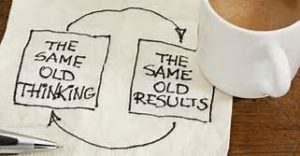‘We’ve Always Done It That Way’ Is A Foolproof Way To Duplicate Your Results

Sticking to the ‘tried-and-true’ is a foolproof way to duplicate results. Indeed, if some process or procedure has always garnered the same result, logically, it will continue to garner that same result—unless an unexpected variable enters the equation.
Same Results. Unexpected Variables.
These two factors are the reason why sticking to the tried-and-true can prove to be more harmful to your business than it is helpful. Comfort zones are a beautiful place where nothing ever grows.
First, doing things the way you have always done them means that you will continue to see the same results repeatedly. You can frame this approach two ways:
- Doing the same thing and getting the same results means that you do not have to worry about regression. A certain standard of results is definite; you will not fall below that standard (assuming unexpected/external variables do not arise).
- Doing the same thing and getting the same results means that you have reached the pinnacle of success. The option to become better is not available; results that are more effective are not possible.
In all senses of the word, you have plateaued. You will not fall any lower than where you stand, and you will also never reap the rewards of climbing higher. You believe you have reached a level of stability however you are really standing on the steady ground of stagnation.
The second factor that makes the tried-and-true method a threat to your success is the fact that you cannot control the incidence of unexpected variables, which are bound to arise and affect your business. Today, technology and human innovation is growing exponentially changing markets, redefining consumer needs, and creating an unprecedented level of competition.
Take Kodak for example; at one point, the photography company was at the top of its industry. They began to witness advancements in technology that produced a shift away from traditional film photography. The imaging giant faced the challenge of changing and adapting to a new environment molded and defined by the digital revolution. An unwavering complacency and inability—or unwillingness—to combat the inevitable changes of the digital world sent Kodak’s film brand Kodacrome into retirement in 2009 after 74 years in business. In 2012, after 133 years in business, the company filed for bankruptcy and suffered the same fate as many of the other failed companies who held too rigidly to the “we’ve always done it this way” mantra.
External variables may be out of your control, but responding to those changes and thinking differently is most certainly in your control. Complacency may feel a lot like stability, but it can stagnate your capacity and opportunity to reach your full potential.
Begin by asking yourself: What is today’s opportunity? Is there a better way that I can operate my business, organization, or company to think about customer experience? How do I raise the bar on what I am currently doing? The real magic happens when we begin to think differently; to provoke thought we must ask questions.
When Charles Darwin introduced the concept ‘survival of the fittest’, he was not speaking about the strongest, the biggest, or the fastest. The ‘fittest’ are those who are the most adaptable to change. You do not have to abandon the strategies and frameworks that have resulted in success, however you do need to keep an open-mind and continue to strive for more.
Take what works and make it better. Stay dynamic and fluid. Assess and reassess. Instead of thinking “We’ve always done it this way”, ask yourself “Is there a better way to do this?”



